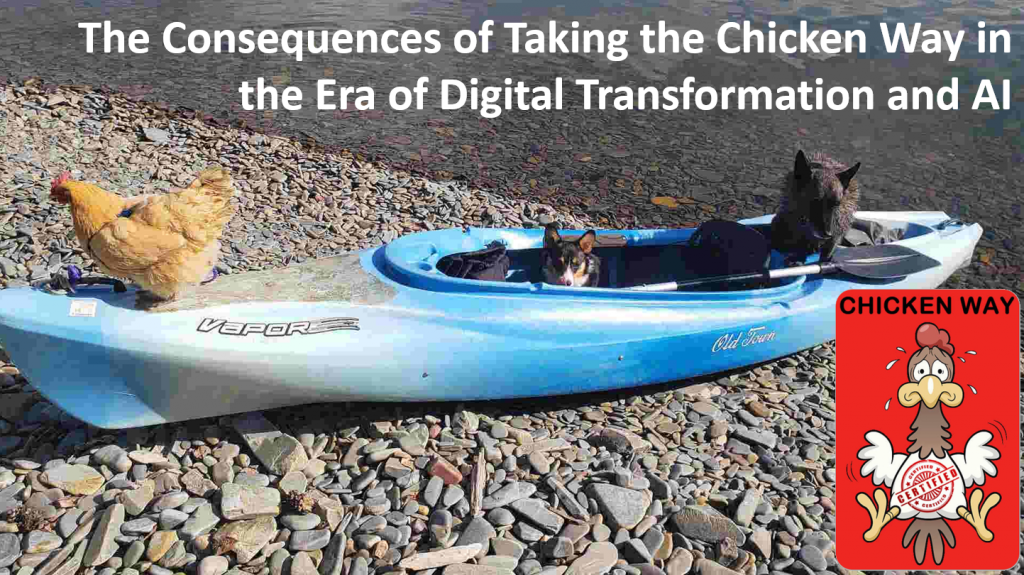In the exhilarating world of kayaking, there’s a term we use – “taking the chicken way.” This phrase is often used when, instead of bravely navigating the challenging rapids, people opt for what appears to be a safer, less intimidating path.

However, this so-called “chicken way” is not necessarily safer at all. It’s a metaphor that beautifully encapsulates the choices we often face, not just in kayaking, but in many aspects of life, including the realm of digital transformation and artificial intelligence (AI).

In 2019, at the Integrate conference, I introduced this concept to the IT world, creating the “Chicken Way Card.” This red card serves a unique purpose – it’s a tool to be used when someone is about to take the “chicken way” in the IT world. Imagine being in a meeting, discussing strategies or solutions, and when something proposed seems like a “chicken way” – an easy way out, a path of least resistance – I show the card. It’s a humorous, light-hearted method to break the tension, adding a touch of fun to critical situations and making them more relaxed.
The Chicken Way Card, first introduced at Integrate 2019, has since found its way into many hands. Many people have adopted its use, and I often receive requests for more cards. It’s heartening to see how this concept has resonated with so many, helping to challenge the status quo and encourage more courageous decision-making in the face of digital transformation and AI. In light of this, I’ve created additional cards for the upcoming Integrate 2023 conference, ready to bring them along with me.
Digital transformation is the process of integrating digital technology into all areas of a business, fundamentally changing how you operate and deliver value to customers. It’s not just about swapping out old systems for new ones; it’s about rethinking old business models and processes in light of the possibilities offered by the latest technologies. It’s about being more agile, more efficient, and more customer-centric.
Artificial Intelligence, or AI, on the other hand, is a branch of computer science that aims to create systems capable of performing tasks that would normally require human intelligence. These tasks include learning, reasoning, problem-solving, perception, and language understanding. AI is not just a futuristic concept; it’s here, and it’s already making a significant impact across various sectors.
One company that’s truly embracing AI and digital transformation is Microsoft. The strides they’ve made, as showcased in their recent Microsoft Build event, are nothing short of impressive. They’ve integrated AI across their technological areas, from cloud computing to business applications, data analytics, and beyond. They’re not just adopting AI; they’re embedding it into the very fabric of their products and services, demonstrating a commitment to innovation that’s both inspiring and challenging for the rest of the industry.
As these technologies continue to evolve and mature, their impact will only grow. The key is not to shy away from these changes or take the “chicken way” out. Instead, we must embrace these technologies, understand their potential, and leverage them to drive innovation and growth. After all, in the rapids of digital transformation and AI, it’s the brave who will navigate the currents and emerge victorious.
As we delve deeper into the era of digital transformation and AI, it’s essential to understand the risks associated with taking the “chicken way” – that is, avoiding or resisting these technological advancements.
One of the most immediate risks is falling behind competitors. In today’s fast-paced digital world, businesses that fail to adapt and innovate are often left in the dust. Take the case of Blockbuster, for instance. Once a giant in the video rental industry, Blockbuster failed to recognize the potential of digital streaming services.

As a result, they were unable to compete with companies like Netflix, which embraced digital transformation and redefined the industry.
Failing to meet customer expectations can also damage a company’s reputation, which can have long-term consequences. Consider the case of a major airline that faced a severe backlash when a system outage led to thousands of cancelled flights. The outage was attributed to outdated IT systems, highlighting the risks of failing to keep up with digital transformation.
Moreover, avoiding AI can mean missing out on opportunities for efficiency and growth. AI can automate routine tasks, freeing up employees to focus on more strategic, value-adding activities. It can also provide valuable insights that can drive decision-making and innovation. Companies that resist AI may find themselves at a disadvantage in terms of productivity and innovation.
Taking the “chicken way” in the face of digital transformation and AI can have serious consequences. It’s not just about keeping up with the latest trends; it’s about staying competitive, meeting customer expectations, and positioning your business for future growth. As we continue to navigate the rapids of digital transformation and AI, it’s the brave who will seize the opportunities and thrive.
While the risks of taking the “chicken way” are significant, the benefits of embracing digital transformation and AI are even more compelling.
One of the most immediate benefits is increased efficiency. By automating routine tasks, AI can free up time for employees to focus on more strategic, value-adding activities. For instance, in the banking sector, AI-powered chatbots are now handling customer inquiries, allowing human customer service representatives to focus on more complex issues. This not only improves efficiency but also enhances customer service.

Improved customer service is another major benefit. With AI, businesses can provide personalized experiences at scale. For example, online retail giant Amazon uses AI to provide personalized product recommendations, enhancing the shopping experience for millions of customers. This level of personalization was simply not possible before the advent of AI.
Digital transformation and AI also open up new business opportunities. They enable businesses to create new products and services, enter new markets, and even redefine existing industries. Take the case of Uber, for example. By leveraging digital technology, Uber disrupted the traditional taxi industry and created an entirely new business model.
Embracing digital transformation and AI can lead to better decision-making. AI can analyze vast amounts of data to uncover insights that would be impossible for humans to find manually. These insights can inform strategic decisions, leading to better business outcomes. For instance, Netflix uses AI to analyze viewing patterns and inform decisions about which shows to produce.

In my opinion, one common reason for resistance is a lack of understanding. Digital transformation and AI are complex concepts that can be intimidating to those who are unfamiliar with them. This lack of understanding can lead to fear and resistance, as people naturally tend to avoid what they don’t understand.
Another common reason is the fear of job loss. With all the talk of AI and automation, it’s understandable that some people might fear that their jobs will become obsolete. This fear can lead to resistance, as people may feel threatened by these new technologies.
So, how can we overcome these fears and resistance?
Overcoming fears and resistance to digital transformation and AI is a significant challenge, but it’s one that we can meet head-on with the right strategies. One such strategy that I’ve developed and am passionate about promoting is the concept of Harmonic Augmentation.
Harmonic Augmentation represents the harmonious fusion of human and AI, a mutual enhancement that leads to the creation of a superhuman entity. It’s a concept that I believe holds immense potential in the world of digital transformation and is the secret to successful utilization of AI.
Here some simple steps on how we can beat these fears and resistance, using Harmonic Augmentation:

Firstly, education is key. By providing clear, accessible information about digital transformation and AI, we can demystify these concepts and help people understand their potential benefits. This could involve workshops, seminars, or even online courses. In these educational settings, the principle of Harmonic Augmentation can be introduced, helping individuals understand how human and AI can work together harmoniously for mutual enhancement.
Secondly, training is crucial. By equipping people with the skills they need to work with these new technologies, we can help alleviate fears about job loss and build confidence. Microsoft, for instance, has launched various initiatives to provide AI training to employees, helping them to adapt to the changing technological landscape. These training programs can also incorporate the concept of Harmonic Augmentation, demonstrating how AI can be used to augment human capabilities, rather than replace them.
Gradual implementation is another effective strategy. Instead of trying to implement everything at once, start with small, manageable projects. This allows people to get comfortable with the new technologies and see their benefits firsthand, which can help to build support for larger initiatives. Each of these projects can be seen as a step towards achieving Harmonic Augmentation, with each success serving as a demonstration of the power of this concept.
Finally, it’s important to foster a culture of innovation and openness to change. This involves encouraging curiosity, experimentation, and a willingness to take risks. Remember, it’s not about avoiding the rapids; it’s about learning to navigate them. And with Harmonic Augmentation as our compass, we can navigate these rapids with confidence, knowing that we are working towards a future where humans and AI work together in harmony, each enhancing the other to achieve more than they could independently.
While fear and resistance are natural reactions to change, they can be overcome with the right strategies. By embracing education, training, gradual implementation, and a culture of innovation, we can help individuals and organizations navigate the rapids of digital transformation and AI, avoiding the “chicken way” and seizing the opportunities that lie ahead.
In this era of rapid technological change, taking the “chicken way” is not an option if we want to stay competitive and relevant. Digital transformation and AI are not just trends; they’re powerful tools that can drive efficiency, innovation, and growth.
So, I encourage you, whether you’re an individual, a team leader, or a business owner, to embrace these technologies. Don’t shy away from the rapids; learn to navigate them. Equip yourself with the knowledge and skills you need to leverage these technologies to their full potential.
Remember, in the rapids of digital transformation and AI, it’s the brave who will navigate the currents and emerge victorious. Don’t take the “chicken way.” Be brave, embrace the change, and seize the opportunities that lie ahead.

And if you’re at #Integrate2023, don’t hesitate to come and find me. I’ve got a Chicken Way Card for everyone. It’s a fun reminder to avoid the easy path and instead, embrace the challenges that lead to growth and success. Good luck on your journey!

